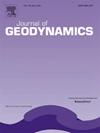利比亚Sirt盆地中部Kotla地堑多期构造沉降机制定量模拟及岩石圈伸展控制演化
IF 2.1
3区 地球科学
Q2 GEOCHEMISTRY & GEOPHYSICS
引用次数: 0
摘要
科特拉地堑仍然是一个调查不足的地区。随着时间的推移,了解地堑及其邻近基底高地的结构对于解决过渡性加速沉降对热沉降和盆地边界断层重新激活机制的影响至关重要,这些机制形成了这样一个地堑。本研究试图利用来自47个钻孔的井数据和26个二维地震反射剖面的组合,恢复中部Kotla地堑的晚白垩世-中始新世的几何形状,其中9个被选中展示了深埋地堑现今结构的新信息。这种地质和地球物理的结合使许多变量能够参与回剥和岩石圈拉伸计算。背带沉降曲线的形状揭示了4个离散的沉降-隆升构造阶段(I-IV),这些阶段以不同的速率被识别,并被3种不同类型的不整合区分开。裂谷在塞诺曼尼亚期开始,两个高点在三东尼亚期被抬升。裂谷作用在古新世达到顶峰,始新世热沉降期结束。地震解释表明,声学基底通常具有三个主要的基底内反射(IRP)包,位于Dahra台地基底内,在本研究中被称为Dahra剪切带。然而,地震分析也可以识别出四种不同的地震相单元。这些相单元与三个公认的伽马射线测井趋势相结合,在构造沉降阶段的不同边界内联系岩性变化。地堑几何构造沉降图显示,在同裂谷期和裂陷期后,中科特拉地堑的沉积中心位于南侧。两种不同的拉伸系数(β)估算方法:沉降引起的拉伸显示岩石圈拉伸范围为1.0 ~ 1.5。此外,断层衍生的跨中科特拉地堑的拉伸在1.5 ~ 2之间,表明地堑轴线的最大地壳拉伸在50 % ~ 100 %之间。这种差异被称为“扩展差异”。本文章由计算机程序翻译,如有差异,请以英文原文为准。
Quantitative modelling of multiphase tectonic subsidence mechanism and lithospheric stretching controls on the evolution of the Central Kotla Graben, Sirt Basin, Libya
The Kotla Graben remains a poorly investigated region. Understanding the architecture of the graben and adjacent basement highs through time is critical for resolving due to the impacts of transitional accelerated subsidence to thermal sagging and basin-bounding fault reactivation mechanisms that create such a graben. This study attempts to restore the Late Cretaceous-Middle Eocene geometry of the Central Kotla Graben, using a combination of well data from 47 boreholes and twenty-six 2D seismic reflection profiles, nine of which are selected to show examples of the new information on the present-day architecture of the deeply buried graben. This geological and geophysical integration has enabled many variables to be involved in backstripping and lithospheric stretching calculations. The shape of backstripped subsidence curves reveals four discrete tectonic (I–IV) phases of subsidence-uplift that are recognised with variable rates and separated by three different types of unconformities. The rifting initiated during the Cenomanian, and both highs were uplifted during the Santonian. The rifting peaked during the Palaeocene and was terminated by a thermal sagging phase during the Eocene. Seismic interpretation indicates that the acoustic basement is generally characterised by three main intra-basement reflection (IRP) packages, located within the Dahra Platform basement and referred to as the Dahra Shear Zone in this study. However, seismic analysis has also enabled the recognition of four different seismic facies units. These facies units are integrated with three recognised gamma-ray log trends to correlate lithological variations within the distinctive boundaries of the tectonic subsidence phases. The tectonic subsidence maps of the graben geometry indicate that during the syn- and post-rift phases, the depocentre of the Central Kotla Graben is located in the south. Two different techniques used to estimate the stretching factor (β): The subsidence-derived stretching revealed lithospheric stretching ranged from 1.0 to 1.5. Moreover, the fault-derived stretching across the Central Kotla Graben ranged from 1.5 to 2, suggesting that the maximum crustal stretching in the graben axis ranges from 50 % to 100 %. This discrepancy is described as “extension discrepancy”.
求助全文
通过发布文献求助,成功后即可免费获取论文全文。
去求助
来源期刊

Journal of Geodynamics
地学-地球化学与地球物理
CiteScore
4.60
自引率
0.00%
发文量
21
审稿时长
6-12 weeks
期刊介绍:
The Journal of Geodynamics is an international and interdisciplinary forum for the publication of results and discussions of solid earth research in geodetic, geophysical, geological and geochemical geodynamics, with special emphasis on the large scale processes involved.
 求助内容:
求助内容: 应助结果提醒方式:
应助结果提醒方式:


